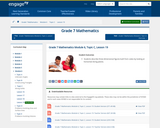
In this lesson, students describe three-dimensional figures built from cubes by looking at horizontal slicing planes.
- Subject:
- Mathematics
- Material Type:
- Lesson Plan
- Provider:
- EngageNY
- Date Added:
- 02/09/2017

In this lesson, students describe three-dimensional figures built from cubes by looking at horizontal slicing planes.
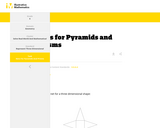
This is a task from the Illustrative Mathematics website that is one part of a complete illustration of the standard to which it is aligned. Each task has at least one solution and some commentary that addresses important aspects of the task and its potential use.

This is an introductory project-based lesson. It is assumed that background knowledge of vocabulary, procedural steps, and concept have been previously instructed. In this project, students will create a square-based pyramid net that would represent their actual tent. Then, they will need to figure out how much fabric that they will need in order to cover their tent. Extensions are built into this activity that would allow the students to practice / explore skills with decimals, percents, and ratios.

This parent guide supports parents in helping their child at home with the 6th grade Math content.

This resource accompanies our Rethink 6th Grade Math course. It includes ideas for use, ways to support exceptional children, ways to extend learning, digital resources and tools, tips for supporting English Language Learners and students with visual and hearing impairments. There are also ideas for offline learning.

In this project, students will create videos that describe what surface area is, what algorithmic steps are needed to find surface area, and finally, they will show how to find the surface area of a polyhedron. Note: This lesson assumes that students have had previous lessons on surface area. This lesson is meant to be sort of a summative assessment tool in which students show their conceptual and procedural fluency of surface area.
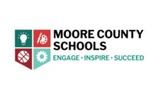
Students have been hired by a postal service to create boxes based on given dimensions and find the total surface area.
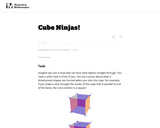
This is a task from the Illustrative Mathematics website that is one part of a complete illustration of the standard to which it is aligned. Each task has at least one solution and some commentary that addresses important asects of the task and its potential use. Here are the first few lines of the commentary for this task: Imagine you are a ninja that can slice solid objects straight through. You have a solid cube in front of you. You are curious about what 2-dimensional ...

In this lesson, students will be creating boxes for candy which will help students understand measuring volume and surface area.
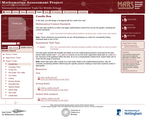
Students will design a hexagonal gift box made from cardstock.

This is an interactive lesson plan with videos, questions, and activities pertaining to area, surface area, and volume. It is a fun and engaging activity in which students pretend they are renovating their bedrooms and have to figure out how much of a material to by based on area measurments.

This task is primarily about volume and surface area, although it also gives students an early look at converting between measurements in scale models and the real objects they correspond to.

This document provides sample performance tasks/assessment items for Common Core State Standards Grade 6 Math provided by the Louisiana Department of Eduation. Both questions and exemplary responses are included.
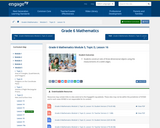
In this lesson, students construct nets of three-dimensional objects using the measurements of a solid’s edges.
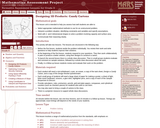
This lesson unit is intended to help teachers assess how well students are able to: Select appropriate mathematical methods to use for an unstructured problem; interpret a problem situation, identifying constraints and variables, and specify assumptions; work with 2- and 3-dimensional shapes to solve a problem involving capacity and surface area; and communicate their reasoning clearly.

Create customized activity sheets for your classroom! Nets of 3-D shapes, tessellations, coordinate graphs, and more - all based on your input.

Students to explore various geometric solids and their properties in this student interactive, from Illuminations. Students can virtually manipulate and color each solid to investigate properties such as the number of faces, edges, and vertices. Students can explore tetrahedrons, cubes, octahedrons, dodecahedrons, icosahedrons, and irregular polyhedrons by toggling between solid and net to see different views of the selected shape.
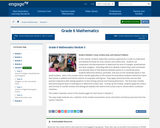
In this module, students utilize their previous experiences in order to understand and develop formulas for area, volume, and surface area. Students use composition and decomposition to determine the area of triangles, quadrilaterals, and other polygons.


Lesson OverviewStudents find the area of a parallelogram by rearranging it to form a rectangle. They find the area of a trapezoid by putting together two copies of it to form a parallelogram. By doing these activities and by analyzing the dimensions and areas of several examples of each figure, students develop and understand area formulas for parallelograms and trapezoids.Key ConceptsA parallelogram is a quadrilateral with two pairs of parallel sides. The base of a parallelogram can be any of the four sides. The height is the perpendicular distance from the base to the opposite side.A trapezoid is a quadrilateral with exactly one pair of parallel sides. The bases of a trapezoid are the parallel sides. The height is the perpendicular distance between the bases.You can cut a parallelogram into two pieces and reassemble them to form a rectangle. Because the area does not change, the area of the rectangle is the same as the area of the parallelogram. This gives the parallelogram area formula A = bh.You can put two identical trapezoids together to form a parallelogram with the same height as the trapezoid and a base length equal to the sum of the base lengths of the trapezoid. The area of the parallelogram is (b1 + b2)h, so the area of the trapezoid is one-half of this area. Thus, the trapezoid area formula is A = 12(b1 + b2)h.Goals and Learning ObjectivesDevelop and explore the formula for the area of a parallelogram.Develop and explore the formula for the area of a trapezoid.